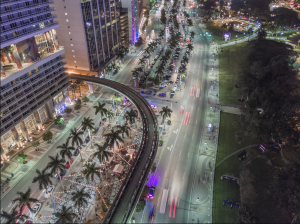Posted February 21, 2017
By ETTY GROSSMAN
Historically, Downtown Miami’s Biscayne Boulevard has been a fast, wide, car-oriented roadway. With eight lanes only for traffic and six blocks of parking, the boulevard falls short of space for people and their community needs.
That’s why, as an attempt to find a balance between the valuable public space dedicated to both cars and people, the Downtown Development Authority decided to launch Biscayne Green, a temporary pop-up park and friendly pedestrian promenade project.
From Jan. 6 until Jan. 26, 2017, three blocks of parking on Biscayne Boulevard under the Metromover tracks were transformed into green spaces.
The parking spaces were occupied by pop-up events such as concerts, movie screenings, dance and yoga lessons, food and beer tastings and a temporary exhibition of artworks from local artists.
“Scenarios such as Biscayne Green contribute a lot to the value of the neighborhood and to the lives in the community,” said Biscayne Green Project Manager and DDA Urban Design and Transportation Planning Manager, Fabian De La Espriella. “They also add personality to the city; they bring interest, fun, charm and most important, community pride.”
The idea of transforming the boulevard into a walkable space was established back in 2009 when the downtown master plan was adopted by the DDA’s Board of Directors. The master plan included a long-term vision of redesigning Biscayne Boulevard to include a pedestrian promenade and adapt the space so it could become an identifiable destination of the city, akin to Barcelona’s famed Las Ramblas or San Francisco’s Embarcadero.
Even though the idea has been years in the making, it was only until 2016 when the DDA found an opportunity to accomplish it.
“Since we don’t get enough government funding for these types of projects, we had to look for other alternatives and that’s how we found out about the Knight Foundation ‘Knight Cities Challenge,’” said De La Espriella. “Out of 45,000 ideas, our project was selected among 158 ideas to submit a final proposal and finally Biscayne Green won a spot within 37 other projects.”
The philanthropic organization awarded $ 146,000 to the DDA to execute the vision of the idea it had in mind.
“When deciding to fund any initiative, the Knight Foundation looks at three things: Authenticity and inclusion, innovation and artistic excellence,” said the Knight Foundation’s Director of Arts, Bahia Ramos. “Biscayne Green not only had all of the requirements, but it would also do something that is crucial in our days: it would help ordinary people understand and enjoy the arts.”
The first block of the project was used for food trucks, presentations, and planning meetings, while the second block was transformed into a mini-park with a kids playground, exercise stations and a dog park. The last block was made simply into a plaza with tables and seating for people to hang out.
Among all of the three blocks, art was very much present. There was a design or work of art from local artists over each column of the Metromover corridor in front of Bayfront Park.
“I believe that art has a great component of transformation,” said De La Espriella. “That’s why one of the initial ideas that actually endured was to make a call to local artists to be engaged with Biscayne Green and the community.”
Cuban Artist Dania Sierra was one of the 16 selected artists. Her art piece “The Queen’s Court” graced one of the pillars during the entire month.
“Miami, in the last couple years, has been growing as a platform for artists, so it is important to keep up with all that is trending,” she said. “This project not only brings exposure to me but also beautifies the area, and engages the public with cultural happenings.”
Eric Krabeling, Drew Cooper, Natalia Valera, Sean Teixeira, Carlos Gonzales, Gianna DiBartolomeo and Humbert Fleitas were some other artists that took advantage of the project to exhibit their work.
Without a doubt, Biscayne Green created a habitable and enjoyable space. It got a lot of attention and the number of people that participated exceeded the DDA’s expectations.
“The response from the community was amazing,” said De La Espriella. “Hearing people saying things such as ‘Why are you taking this away,’ or ‘We need more community events like this’ was very rewarding.”
Miami City Commissioner and DDA Chairman Ken Russell is so excited about the project and its positive outcomes that by the end of his chair, he wants to make it permanent.
“It would take us a lot of effort and time to recreate what we have done on a permanent basis, and it doesn’t matter because at the end we are responding to a need,” he said.
Biscayne Green’s main goal was to make art general and accessible for everyone. However, the components of the project also helped to connect people to place and to each other by reflecting the diversity and the identity of the community.

